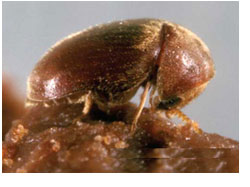Cigarette Beetle
 The cigarette beetle is one of the most common household insect pests along the Atlantic Coast and Gulf Coast States. It can be found throughout the year, but seems to be more common in the fall and winter months. The cigarette beetle is native to Egypt. In fact, a beetle was found in King Tutankhamen's tomb! In the 3,500 years since, it has hardly changed.
The cigarette beetle is one of the most common household insect pests along the Atlantic Coast and Gulf Coast States. It can be found throughout the year, but seems to be more common in the fall and winter months. The cigarette beetle is native to Egypt. In fact, a beetle was found in King Tutankhamen's tomb! In the 3,500 years since, it has hardly changed.
The adult beetles are small, squat and oval, about 1/10 inch long, and are covered with small hairs which give them a silky, yellowish-brown color. The antennae are saw-like and the head is retracted. Many times it is mistaken for the Drugstore Beetle, when identified with the naked eye. Adults are strong fliers and prefer subdued light and temperatures over 65 degrees Fahrenheit. The adults tend to fly in late afternoons and on cloudy, overcast days.
As its name implies, the cigarette beetle is a pest of dried tobacco either in the stored, bundled form or in cigars, cigarettes, and chewing tobacco. This particular species infests tobacco wherever it is stored but is also found infesting many homes. It also feeds on the bindings and leaves of books. The larval stages of the cigarette beetle can feed on a variety of stored products including grain, cereal products, pet foods, rat and mouse baits, pasta, ginger, raisins, rice, dates, pepper, dried fish, drugs, belladonna, dried flower arrangements and seeds. The larvae have been known to feed on upholstered furniture, particularly stuffing. The adult Cigarette Beetle can also feed on pyrethrum powder that is strong enough to kill cockroaches! A serious pantry pest. their range of food makes them difficult to control. There have been larval infestations in dried flower arrangements, causing the flowers to drop or all the petals to fall.
The female produces about 100 eggs, which are deposited on or near the available food supply. These eggs then hatch within 6-10 days. The wormlike larvae are slightly smaller than the adult beetles. Larvae are creamy white except for the yellow head and brown mouth parts. Larvae become full grown in about 40 days. The entire life cycle can be completed in 45-50 days, and there may be 3-6 overlapping generations per year in warmer climates, while one generation per year might be seen in more temperate locations.
The first step in Cigarette beetle control in homes is to find and discard all infested materials. Commonly infested spices include paprika, chili powder, curry, and celery seeds. In addition, these pests may be found in crackers or other dried bread and dry pet food. Residual pesticide applications may be made to potential harborage sites but should never be the sole means of control.
 The cigarette beetle is one of the most common household insect pests along the Atlantic Coast and Gulf Coast States. It can be found throughout the year, but seems to be more common in the fall and winter months. The cigarette beetle is native to Egypt. In fact, a beetle was found in King Tutankhamen's tomb! In the 3,500 years since, it has hardly changed.
The cigarette beetle is one of the most common household insect pests along the Atlantic Coast and Gulf Coast States. It can be found throughout the year, but seems to be more common in the fall and winter months. The cigarette beetle is native to Egypt. In fact, a beetle was found in King Tutankhamen's tomb! In the 3,500 years since, it has hardly changed.